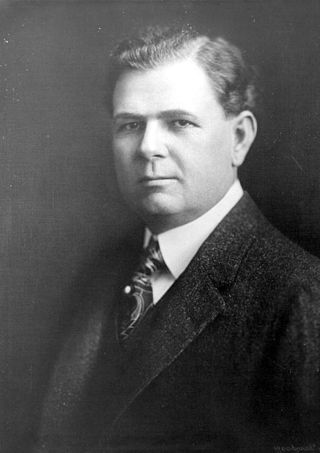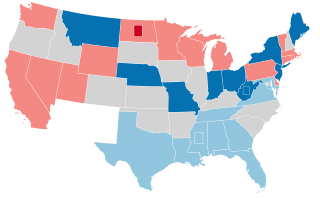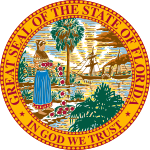
Park Monroe Trammell, was an American attorney and politician from the state of Florida. Trammell represented Florida in the United States Senate from 1917 until his death in 1936. As chair of the Senate Naval Affairs Committee, Trammell was essential in the creation of several laws that revitalized the United States Navy. Trammell previously served as the Governor of Florida and Florida Attorney General.

The 1970 United States Senate elections was an election for the United States Senate. It took place on November 3, with the 33 seats of Class 1 contested in regular elections. Special elections were also held to fill vacancies. These races occurred in the middle of Richard Nixon's first term as president. The Democrats lost a net of three seats, while the Republicans and the Conservative Party of New York picked up one net seat each, and former Democrat Harry F. Byrd Jr. was re-elected as an independent.

The 1958 United States Senate elections were elections for the United States Senate which occurred in the middle of President Dwight D. Eisenhower's second term. Thirty-two seats of Class 1 were contested in regular elections, the new state of Alaska held its first Senate elections for its Class 2 and 3 seats, and two special elections were held to fill vacancies.

The 1950 United States Senate elections occurred in the middle of Harry S. Truman's second term as president. The 32 seats of Class 3 were contested in regular elections, and four special elections were held to fill vacancies. As with most 20th-century second-term midterms, the party not holding the presidency made significant gains. The Republican opposition made a net gain of five seats, taking advantage of the Democratic administration's declining popularity during the Cold War and the aftermath of the Recession of 1949. The Democrats held a narrow 49-to-47-seat majority after the election. This was the first time since 1932 that the Senate majority leader lost his seat, and the only instance of the majority leader losing his seat while his party retained the majority.

The 1936 United States Senate elections coincided with the reelection of President Franklin D. Roosevelt. The 32 seats of Class 2 were contested in regular elections, and special elections were held to fill vacancies. The Great Depression continued and voters backed progressive candidates favoring Roosevelt's New Deal in races across the country. The Democrats gained 5 net seats during the election, and in combination with Democratic and Farmer–Labor interim appointments and the defection of George W. Norris from the Republican Party to become independent, the Republicans were reduced to 16 seats. Democrats gained a further two seats due to mid-term vacancies. The Democrats' 77 seats and their 62-seat majority remain their largest in history.

The 1972 United States House of Representatives elections were held on November 7, 1972, to elect U.S. Representatives to serve in the 93rd United States Congress. This was the first election held after the 1970 United States redistricting cycle. It coincided with the landslide reelection victory of President Richard M. Nixon. Nixon's Republican Party managed to gain a net of twelve House of Representatives seats from the Democratic Party, although the Democrats retained a majority.

The 1910–11 United States Senate election were held on various dates in various states. As these U.S. Senate elections were prior to the ratification of the Seventeenth Amendment in 1913, senators were primarily chosen by state legislatures. Senators were elected over a wide range of time throughout 1910 and 1911, and a seat may have been filled months late or remained vacant due to legislative deadlock. However, some states had already begun direct elections during this time. Oregon pioneered direct election and experimented with different measures over several years until it succeeded in 1907. Soon after, Nebraska followed suit and laid the foundation for other states to adopt measures reflecting the people's will. By 1912, as many as 29 states elected senators either as nominees of their party's primary or in conjunction with a general election.

The 1990 Florida gubernatorial election took place on November 6, 1990. Incumbent Republican governor Bob Martinez ran for a second term in office, but was defeated by Democratic challenger Lawton Chiles, a former U.S. senator.

The 1958 United States Senate election in Florida was held on November 4, 1958.

The 1946 United States Senate election in Florida was held on November 5, 1946.

The 1944 United States Senate special election in New Jersey was held on November 7, 1944.

The 1916 United States Senate election in Minnesota took place on November 7, 1916. It was the first election for either class of U.S. senators held in Minnesota after the ratification of the Seventeenth Amendment to the United States Constitution, which established the popular election of United States senators. Incumbent Senator Moses E. Clapp was defeated in the Republican primary election by former American Bar Association president Frank B. Kellogg. Kellogg went on to defeat former St. Paul Mayor Daniel W. Lawler of the Minnesota Democratic Party, and Prohibition Party challenger Willis Greenleaf Calderwood, in the general election.

The 1928 United States Senate election in Florida was held on November 6, 1928.

The 1934 United States Senate election in Florida was held on November 6, 1934.

The United States Senate elections of 1936 in New Jersey was held on November 3, 1936.

The 1936 United States Senate election in Nebraska was held on November 3, 1936.

The 1936 United States Senate election in Michigan was held on November 3, 1936. Incumbent Republican U.S. Senator James J. Couzens ran for re-election to a third term in office, but was defeated in the Republican primary by Governor Wilber Brucker. Brucker was defeated in the general election by Democratic U.S. Representative Prentiss M. Brown, becoming the first Democrat to win this seat since 1853.

Elections were held in Illinois on Tuesday, November 5, 1940.

Elections were held in Illinois on Tuesday, November 3, 1936.

The 1936 United States Senate special election in Florida was held on November 3, 1936. Charles O. Andrews was easily elected to fill the seat.
























